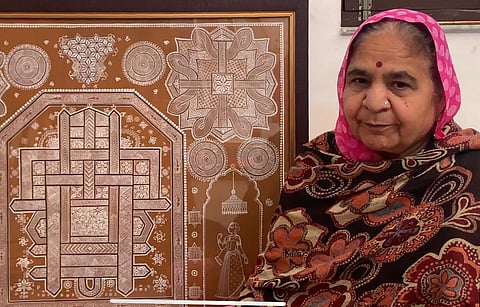
- Destinations
- Experiences
- Stay
- What's new
- Celebrating People
- Responsible Tourism
- CampaignsCampaigns
- Subscribe
- Buy Now

Among ancient art forms dominating India's cultural landscape is "Mandana," a tribal art that has adorned the walls of rural houses for centuries. A tour through the rustic streets of Rajasthan, Gujarat or Madhya Pradesh is a testament to this traditional art form predominantly created on the walls and floors of earthen or kuchcha houses. However, these designs are losing their relevance amid the emergence of pucca (concrete) houses and ready-made stickers. "It is best represented on mud floors. Designs made in a white-red combination perfectly pop out on a floor smeared with soil and cow dung," said Vidya Devi Soni, Mandana artist from Bhilwara, Rajasthan.
Practised by the Meena community, this tribal art has been around for centuries. Despite the lack of records, the origin of Mandana is believed to be from the Vedic age, 1500 to 500 BCE. Derived from "Mandan," which implies decorate, the term "Mandana" translates to "drawing a picture."
Owing to women's social role as nurturers, it is the women within this community who make these beautiful designs. "Even the utensils discovered at the ancient city Mohenjo-Daro have designs of animals, establishing their connection with Mandana," said the 74-year-old artist.
Soni's journey is a tale of skill, heritage and legacy. She learnt to make Mandana designs from her mother, who would make these intricate patterns on several occasions. "From festivities and harvest season to cosmic subjects, Mandana's significance varies from occasion to occasion. The core belief behind drawing these shapes is to welcome the divine into the home. The designs include motifs of birds, elephants, tigers, peacocks, and Gods," added Soni. Their uniqueness is defined by the dominance of red and white colours, central to its identity.
Like many other women in the Meena community, Soni has been practising this art form since 13. However, what saddens her most is the gradual disappearance of this art form. "With the prevalence of ready-made stickers and concrete houses, it has become challenging for us to keep it relevant," she said.
Soni also believes that today's generation is not interested in learning Mandana because of a lack of financial security.
"Our generation had less exposure, so we were keen to learn new things. In those days, we would make these designs out of interest and love. It was not a commercialised art form. I don't see the girls of this generation making designs like we used to. Learning the art form requires time and devotion. But things have changed now. Technology has overpowered traditions."
Had it not been for her father, the idea to bring Mandana on the resurgence map would not have struck Soni. About 8-10 years ago, her father persuaded her to publicise her works and preserve the art form. She now holds workshops and exhibitions nationwide to re-establish its roots. She recently went to Hong Kong to demonstrate the making of these designs and expand its reach beyond the Indian houses.
Soni's son, Dinesh Soni, an award-winning painter, has been helping his mother revive the art form. "I realised the gravity of the issue when people mistook Ba's (mother's) painting for Madhubani paintings and Mandala art." He believes that art historians should pay attention to the subject and try to revive it. "Besides the government, history enthusiasts should delve deeper into the subject and spread the word on the need for today's generation not to isolate themselves from their cultural roots."
Soni has introduced more colours to infuse new life into Mandana paintings. So far, red and white have been the dominant colours for making these motifs; however, the veteran artist now combines different colours to make them more appealing.
Soni's son had written to the state authorities to register the art form; however, the progress has been slow. "Mandana is not listed in the government records. I tried registering it under the endangered craft category but to no avail. I applied about 2-3 years ago, but I am still awaiting a substantial response from the government."
Meanwhile, Soni continues to teach the art form in her family to ensure that it does not vanish. "If it comes to the government's notice, we can preserve its legacy and cultural heritage. Our exhibitions are one way to preserve them. Once people learn about it, they will be curious, and Mandana will automatically be revived. I also request corporate and renowned personalities to support us in preserving this art form."
